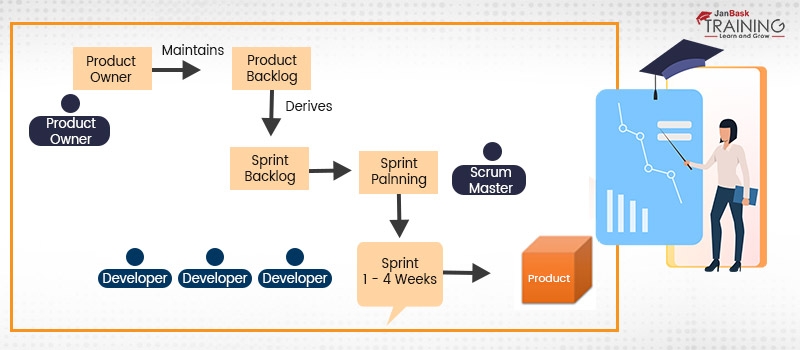12
DecChristmas Offer : Get Flat 35% OFF on Live Classes + $999 Worth of Study Material FREE! - SCHEDULE CALL
Business Analysts and their analysis have come up to a long journey with various project management framework. The time when waterfall models were in use, it was the business analyst who used to finalize the requirement by talking to customers and subject matter experts. But then with the evolution of Agile in the industry, the role of business analysts has been in some confusion and see variations in the form of Product Owners and Product Managers. But still, business analysis in agile is very crucial, as its the BA who can define that all the dynamic and iterative changes that are happening are feasible or not.
The twelve principles on which Agile works are directly or indirectly associated with Agile. Business Analysis visualizes agile and its development from the eye of a business and organization’s business processes.
For any solution which is being built as part of a software development task, its the business analyst who derive real business value, and its ROI from any product feature.
Any team in agile always focuses on the priority items which are being finalized by Product Owners from the backlog. The team must be well aware that which items would bring value to the organization and the roadmap should be aligned accordingly.
But what do you think?
Does that alone happen by the prioritization done by Product Owners and a check on technical feasibility done by the development team?
The answer is “NO”. It's the business analyst who plays a key role in this agile environment by assessing the value of those items to the business.
How about seeing the prime task which analyst facilitates and has to be part of these revolving around people -
This famous and widely accepted fundamental has numerous ways to develop a product, with a co-operative and joined effort to bring out solutions for any customer or business needs. It can be said as a combination of a set of frameworks and proven good practice implied from agile principles.
You know what is the key element that separates agile from all any other or primitive development process?
It focuses on everyone in the organization working collaboratively towards a common business goal. This aspect of Agile is the main goal of the agile community.
So majorly, it focuses on three factors -
Agile software development technique has written many success stories with the organizations because of the following strong reasons behind it -
Read: Discovering the Underlying Competencies of Business Analyst
The diagram below gives a better picture of above explanation -

The agile manifesto behind which the entire agile framework works is a decree that communicates four values and twelve principles, that are believed to be followed for successful product development.
The document which has all these details is known as “Manifesto for Agile Software Development”, which was announced in 2001, by a group of 17 developers.
Agile Manifesto evolved as a result of enormous delay in the business requirements and teams trying an effort to meet all of them. This problem mostly used to occur in waterfall methodology where changes were not so easy to be incorporated.
The values in the Agile Manifesto are -

Now lets’ see the 12 principles behind it -
So now after so much discussion about Agile, let’s perceive its methodology. So in simple words, agile methodology is a practice of continuous development and testing for software development. It is said to be an iterative approach to the development model. Currently, every organization is following agile for their software development, some of them customize it as per organization culture and structure.
Agile looks forward to an incremental and iterative approach, unlike the waterfall method. Agile accepts the change frequently and that’s why agile always believes in smaller deliveries. If I frame it more technically, agile proposes to have a minimum shippable product. And, that’s the sole reason why development and testing happen in a concurrent manner in agile.
The best part about agile is that customers/clients or internal business stakeholders have an early look at what is being developed. This gives them a sense of transparency and they make decisions to change at a much earlier stage. That’s why agile delivery is always planned in phases to accept and implement the changes coming in between.
Agile has proved quite successful for smaller projects, however, for larger projects it becomes difficult to estimate the timeline. That’s the reason any large project which needs to follow agile, is broken down in multiple phases and they are being aligned in the roadmaps.
Learn Business Analyst in the Easiest Way
Read: All You Need to Know About Business Analyst Qualification

With the above context in the picture, we already have a fairly good view of agile. The lifecycle of agile is divided into multiple stages -

All these now make me think about what are the frameworks over which agile functions in the organizations. Mostly there are three frameworks of Agile -
Xtreme programming also focuses on the end result, but what makes it different is the excellent quality code and technical infrastructure that is being set up for software development. The development actually goes beyond their capability to perform extreme programming.
Kanban is mostly associated with process improvements in the agile methodology. It is a very lean method and there are tasks assigned to a team on a daily basis. For companies who release everyday or work directly on the client end, prefers Kanban framework.
Scrum is the framework which is used to solve complex problems and make a smooth delivery for any big feature and business needs. It takes its concepts from the rugby team which focuses on the big game while making teams to work together and achieve a common goal.
The three important roles of any Scrum includes -
Scrum Master - The scrum master acts as a facilitator as well as the leader for the scrum team. He/She manages the development team, maintains the scrum board and performs all scrum ceremonies. The interactions from any other team needs to pass through the eyes of the scrum master.
Development Team - Coders, programmers who drive the requirement from a technical look and delivers a promising feature keeping all its technical feasibility intact formulates this team.
Product Owners - They are the ones who proudly own the product, and states the expectation which needs to be put up to present a strong feature that adds up to commercial value. One of the authoritative and powerful stakeholders with a vision of forming a strong product to hold a grip in the market.
Any Scrum has some driving elements which raise its value more than framework -
Sprint Planning - A regular discussion planned prior to the start of newsprint with the analyst, owners and technical team in place. The discussion happens with the basis of aiming items that can be provided during the next sprint. A check is done on the backlog and accordingly, items are being picked and moved for the current week/month to be progressed.
Read: Business Analyst Salary Guide In 2025
Daily Scrum - Well industry practices different terminologies for this, but it's basically a status call but happens on an everyday basis unlined waterfall. Everyone set forth the task with which they would be occupied for the present day.
Sprint Review - A discussion hosted at the end of running sprint and evaluation happens over the course of work done. This scrum event is organized to make sure the changes that got achieved as part of the current sprint.
Sprint Retrospective - This scrum activity takes place afterward once the review of the sprint has been concluded. The talks between everyone is about
Sprint Burndown Charts - A comparison is done between the tasks assigned and the time left to fulfill it, which is then shown in a graphical format and that forms this chart. At the end of each sprint, it gives a detailed report how well the team performed based on their estimation they made for each development task.
Product Backlog Grooming - This aspect refers to the main job role for which Product Owners are being aligned, and sometimes even the technical people impart their skills to analyze each and every task mentioned in the product backlog. Once all these activities are finalized they happily sit under backlog for Sprint.
Preparation of User Stories - The larger requirements are broken down in granular ones by Product Owners and added as part of User Stories. This helps to describe the requirements much more precisely.
Business Analyst Training & Certification

Agile can be said to be a very dynamic way to look at the development of any software. It has gained so much popularity because of its iterative approach that it has built up many success stories. Apart from the technology industry, we have other industries where organizations are implementing agile for their business growth.
I hope you had a great time learning basic concepts of agile and its importance in the life of business analysts. Happy Learning Learners !!
 Pinterest
Pinterest
 Email
Email
The JanBask Training Team includes certified professionals and expert writers dedicated to helping learners navigate their career journeys in QA, Cybersecurity, Salesforce, and more. Each article is carefully researched and reviewed to ensure quality and relevance.

Cyber Security

QA

Salesforce

Business Analyst

MS SQL Server

Data Science

DevOps

Hadoop

Python

Artificial Intelligence

Machine Learning

Tableau
Search Posts
Related Posts
10 Pro Tips for Growing Businesses to Prepare for Long-Term Success
![]() 4.5k
4.5k
Business Analyst Job Description 2025: Key Responsibilities
![]() 980.9k
980.9k
What Are The Requirements To Become A Business Analyst?
![]() 575.8k
575.8k
How To Choose The Appropriate Business Analyst Certifications?
![]() 303k
303k
Why is a Business Analyst Best Fit for Scrum Environment?
![]() 4.7k
4.7k
Receive Latest Materials and Offers on Business Analyst Course
Interviews